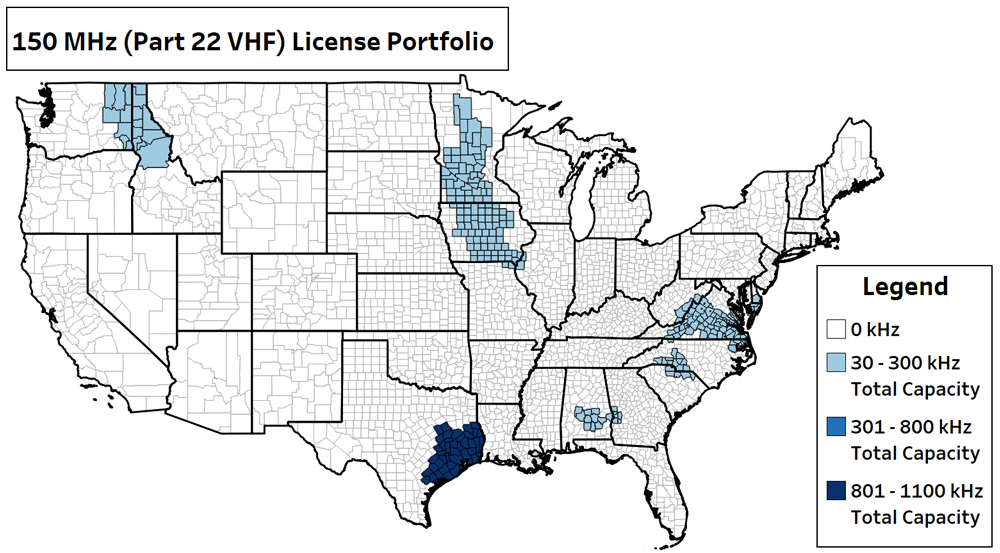Wireless Spectrum Licenses in 150 MHz (Part 22 VHF) Ideal for Land Mobile Radio & Data Applications Available in Texas, Iowa, Minnesota, Virginia & Additional States
Select Spectrum is offering 150 MHz (Part 22 VHF) FCC‐licensed spectrum across portions of 15 states including Texas, Iowa, Minnesota, and Virginia. Major cities covered include Houston, TX, Galveston, TX, Des Moines, IA, Richmond, VA, and Charlotte, NC. Together, these licensescover a population of over 22.7 million across both urban and rural markets. Available spectrum varies, with between 30 to 1,100 kHz bandwidth in each market. In the Texas market areas, significant capacity (860 ‐ 1,100 kHz) is available for purchase. With multiple geographically adjacent and spectrally contiguous licenses, it is possible to combine and deploy sophisticated, high‐bandwidth networks.
Available markets in this offering are shown in the map below:

These licenses can support a wide variety of uses and are ideal for remote monitoring of critical infrastructure, smart grid, utility communications, public safety, and paging. Common uses include land mobile radio, SCADA systems, Oil & Gas production/pipelines, and transportation.
150 MHz VHF spectrum can be used for paging and/or voice or data in one‐way or two‐way or broadcast modes including fixed and mobile services. E Block licenses are unpaired (20 kHz) and are assigned for paging operations, while F Block licenses are paired (2 x 30 kHz) and have an interleaved channel plan that allows full duplexing and simultaneous multipoint digital broadcasts from multiple transmitters on either the upper or lower channel blocks for voice & data applications. Half‐duplex (time‐division duplex “TDD”) is also allowed. Maximum base station power is 1400 Watts ERP, while mobile units may transmit at up to 60 Watts ERP. The generous rules allow for long‐range and high reliability in both high‐density urban areas and rural areas. Networks may employ point‐to‐point, and/or point‐multipoint (tall site) architectures.
Subject to FCC Part 22 Paging rules, the 2 x 30 kHz channel spacing allows for flexibility in land mobile radio and data transmission systems. Each license is permitted 2 x 20 kHz of effective bandwidth with an assigned center frequency, allowing for interference protection and compatibility with narrowband technologies. The FCC is considering a recent proposal (DA 14‐1508) to update the rules, particularly Subpart E, to allow for greater flexibility by permitting usage of the channel spacing & frequency offsets if license holders own adjacent blocks and of innovative technologies such as TETRA and 12.5 kHz/6.25 kHz narrowband equipment. Commenters have unanimously supported the measure, but waivers would be required in the interim to achieve flexibility while satisfying FCC regulatory compliance.
Equipment for the band is made by Ondas Networks, 4RF, XetaWave, Motorola Solutions, ESTeem, Hytera, Kenwood, and Tait Communications. For spectrum blocks of 100 kHz or greater, the band is also compatible with a new IEEE wirelessstandard – 802.16s “GRIDMAN”. This high‐reliability standard is intended for use by utilities and other critical infrastructure operators.
Most licenses cover their entire original assignments, but some licenses in dense markets have been disaggregated in accordance with FCC rules including §22.513 of Title 47, Part 22. Under the same rules, licensees may further disaggregate licenses. Individual call sign information is available upon request. Please contact us for additional information regarding these licenses.
Basic information about the overall offering is shown below:
